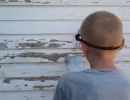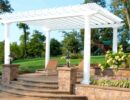Expert advice about aluminum and steel siding, the benefits and drawbacks of metal siding, with tips on installation, maintenance and care.
Metal siding is a popular alternative to wood, vinyl, and other materials in situations where durability is a top priority. The two types of metal used in the manufacture of siding are aluminum and steel. Each has its benefits and drawbacks.
Both aluminum and steel siding are durable, low- maintenance, and fire-resistant. For house cladding, they have been used since the 1940s. They grew significantly in popularity in the 1980s, when the quality and look gained a new sophistication with embossing and coatings realistically simulating wood.
But aluminum and steel siding have negative traits, too. They are energy-intensive to manufacture, the metals are not a renewable resource (though some can be recycled), and the products often require shipping.
For more on painting or repairing aluminum siding, see How to Paint Aluminum Siding and Aluminum Siding Repairs.
Aluminum Siding
The virtues of aluminum siding are that it won’t rot, rust, or blister and that it is fireproof and impervious to termites. Its drawbacks are that it dents and scratches easily and may corrode without proper care.
Aluminum siding comes as extruded panels in a wide range of factory-baked colors and textures. Styles and dimensions are similar to those for vinyl, though some 12-by-36-inch and 12-by-48-inch panels simulate cedar shakes. If cared for properly, aluminum siding can last from 40 years up to the life of the house.
Maintaining aluminum siding consists of little more than hosing it off annually, cleaning surface stains with non-abrasive detergent, and periodically refinishing with paint recommended by the manufacturer.
Because aluminum is lightweight and easy to handle, installation is very manageable by do-it-yourselfers with mostly basic skills and tools.
Steel Siding
Steel siding has similar benefits to aluminum—it rejects insects and rot and is resistant to fire—but it can be scratched and rust. It is stronger, heavier, and more resistant to denting than aluminum. Professional installation is recommended.
Steel siding panels are extruded in the same types of panels as aluminum (and vinyl) siding. The material is given a baked-on, guaranteed finish in a broad array of colors in textures that are smooth or mimic the look of wood grain.
Maintenance is easy—you just hose it down once a year. If scratches appear, prime and paint the material before rust can develop. With basic care and maintenance, this siding will last 40 years or more.









 Don Vandervort writes or edits every article at HomeTips. Don has:
Don Vandervort writes or edits every article at HomeTips. Don has:




